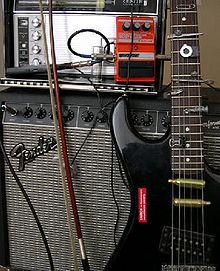Invented in 1931, the electric guitar became a necessity as jazz musicians sought to amplify their sound in the big band format. During the 1950s and 1960s, the electric guitar became the most important instrument in pop music. It has evolved into a stringed musical instrument that is capable of a multitude of sounds and styles. It served as a major component in the development of rock and roll and many other genres of music.
Playing techniques
Extended techniques include:-
- String bending. This is not quite unique to the electric instrument, but is greatly facilitated by the light strings typically used on solid body guitars.
- Neck bending, by holding the upper arm on the guitar body and bending the neck either to the front or pulling it back. This is used as a substitute for a tremolo bar, although not as effective and too powerful of force use could snap the guitar neck.
- The use of the whammy bar or "tremolo" arm, including the extreme technique of dive bombing.
- Tapping, in which both hands are applied to the fretboard.
- Pinch harmonics, sometimes called "squealies". This technique involves adding the edge of the thumb or the tip of the index finger on the picking hand to the regular picking action, resulting in a high pitched sound.
- Volume swells, in which the volume knob is repeatedly rolled to create a violin-like sound. Note that the same result can also be accomplished through the use of an external swell pedal, although the knob technique can enhance showmanship and conveniently eliminate the need for another pedal.
- Use of audio feedback to enhance sustain and change timbre.
- Substitution of another device for the plectrum, for instance the cello bow (as famously used by Jimmy Page) and the e-bow, (a device using electromagnetic feedback to vibrate strings without direct contact). Like feedback, these techniques increase sustain, bring out harmonics and change the acoustic envelope.
- Sustainers built into the guitar itself.
- Use of slide or bottlenecks.
- Sometimes guitars are even adapted with extra modifications to alter the sound, such as Prepared guitar and 3rd bridge.


